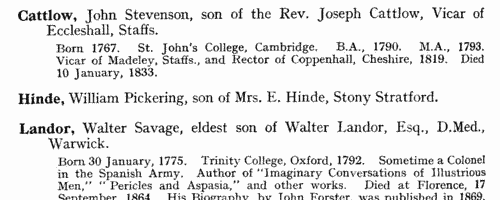Add this eBook to your basket to receive access to all 2,600 records. Our indexes include entries for the spelling atkinson. In the period you have requested, we have the following 2,600 records (displaying 1,271 to 1,280): These sample scans are from the original record. You will get scans of the full pages or articles where the surname you searched for has been found. Your web browser may prevent the sample windows from opening; in this case please change your browser settings to allow pop-up windows from this site. Petitioning Creditors and Solicitors
(1840)
Principal creditors petitioning to force a bankruptcy (but often close relatives of the bankrupt helping to protect his assets): and solicitors | Sample scan, click to enlarge

| Tenants and occupiers of East Ruston
(1840)
The register of electors entitled to vote in any parliamentary election for East Norfolk between 1 November 1840 and 1 November 1841 lists 8,556 freeholders arranged by hundred and within hundred by parish or township &c. In the first column, after number within the register, the elector's name is given (surname first); the second column gives place of abode; the third column the nature of qualification (such as 'owner and occupier'); and the fourth column the address of the qualifying property, in some cases with the name of the tenant or occupier. | Sample scan, click to enlarge

| Trustees and Solicitors
(1840)
Trustees appointed to take over bankrupts' estates in England and Wales, and their solicitors. Trustees are often friends or relatives of the bankrupt: and/or principal creditors
| Sample scan, click to enlarge

| Bankrupts
(1841)
Bankruptcy notices for England and Wales: bankruptcy often caused people to restart their lives elsewhere, so these are an important source for lost links
| Sample scan, click to enlarge

| Bankrupts' Assignees
(1841)
Assignees of bankrupts' estates (usually principal creditors and/or close relatives of the bankrupt) in England and Wales | Sample scan, click to enlarge

| Bankrupts' Assignees
(1841)
Assignees of bankrupts' estates (usually principal creditors and/or close relatives of the bankrupt) in England and Wales | Sample scan, click to enlarge

| Boys entering Rugby School
(1841)
This edition of Rugby School Register was published in 1933: the volume covering 1675 to 1857 contains 6480 entries, based on the original school admission registers, but elaborated with general biographical information wherever the editor was able to do so. The entries for the 17th and early 18th centuries are much less detailed than those for later years. The arrangement of the fullest entries was to give the boy's full name (surname first, in bold); whether eldest, second, &c., son; father's name and address as of when the boy entered school; the boy's age at entry and birthday; name of the house (in the school) to which he belonged; then a brief general biography; and date and place of death. | Sample scan, click to enlarge

| British Army administration
(1841)
The British Army of queen Victoria's time had a very extensive system of administration. The Royal Kalendar lists officials, both uniformed and civilian, from the Commander-in-Chief's Office at Horse Guards, the Adjutant-General's Office, the Recruiting Department, the Quarter Master-General's Office, the Judge Advocate-General's Office, the Consolidated Board of General Officers, the Cinque Ports, the War Office, the Office of her Majesty's Paymaster-General, the Ordnance Department (including the out-ports and stations at Woolwich, Chatham, Dover, Portsmouth, Devonport, Guernsey, Jersey, Chester and Liverpool, Carlisle, Hull, Landguard Fort and Harwich, Alderne, the gunpowder manufactory at Waltham Abbey, the gunpowder magazines at Hyde Park, Purfleet, Gravesend and Tilbury, Upnor Castle, Priddy's Hard, Tipner Point, Keyham Point, Marchwood and Tynemouth; at Edinburgh, Stirling Castle and Fort George in Scotland; in Antigua, Australia, the Bahamas, Barbadoes, Berbice, Bermuda, Cape of Good Hope, Colombo, Corfu, Demerara, Dominica, Gibraltar, Grenada, Halifax (Nova Scotia), Jamaica, Isle aux Nois, Kingston (Upper Canada), Malta, Mauritius, Montreal, New Brunswick, Prince Edward's Island, Quebec, Rideau Canal, Ottawa Canals, St Christopher, St Helena, St Lucia, St Vincent's, Santa Maura, Sierra Leone, Toronto, Tobago, Trincomalee, Trinidad and Zante), the Royal Military College at Sandhurst, the Royal Hospital at Chelsea, the Royal Military Asylum at Chelsea and Southampton, Army Agents, General Agents for the Recruiting Service, and Army general staff and governors of forts and garrisons in Ireland. | Sample scan, click to enlarge

| British sea officers
(1841)
The Royal Kalendar lists the 177 flag officers of the Royal Navy; the 670 captains (including superannuated and retired) and 751 commanders. The captains and commanders are given in order of precedence, determined by the dates of their appointment. Then there is a list of the ships of the navy, annotated with the names of their captains, with a separate section for steam vessels; packet brigs at Falmouth; and mail steam vessels at Dover, Weymouth, Pembroke, Liverpool, Holyhead and Portpatrick. | Sample scan, click to enlarge

| County Cork Freeholders: Booth No 6
(1841)
The poll books of voters in the parliamentary election for county Cork 13 to 15 July 1841 delivered in to the select committee that subsequently looked into the propriety of the proceedings, and then annotated with observations as to those votes to which objection had been raised. There are separate books for seven booths, with the electors' names in order of voting: giving each freeholder's full name, place of abode, situation of the freehold, value, number and date in the alphabetical registry book, and for which candidates they voted (Daniel O'Connell, Edmund Burke Roche, Nicholas Philpot Leader, and Robert Longfield). The seven booths are for these areas: 1. Duhallow barony; 2. Hall County Side, East East Carbery, West East Carbery and East West Carbery; 3. Barrymore and West West Carbery; 4. Condons and Fermoy; 5. Imokelly and West Muskerry. | Sample scan, click to enlarge

|
Research your ancestry, family history, genealogy and one-name study by direct access to original records and archives indexed by surname.
|











